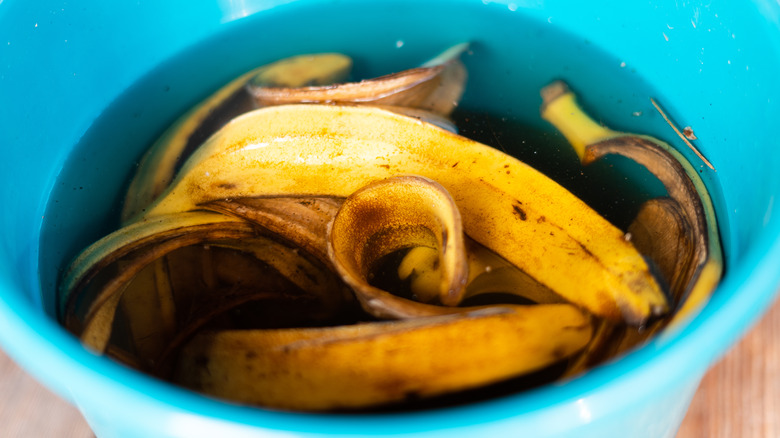Is It Safe To Eat Banana Peels?
When you think of banana peels you probably think either "garbage" or a cartoon character comically slipping. Few people when looking at the hard, rubbery outer layer of fruit think "food," but should they?
Bananas as a fruit are an excellent source of vitamin C, potassium, fiber, and magnesium. They're low in sugar, fat free, and easy to get any time of year, so it's no wonder that the International Fresh Produce Association lists them as the most popular fruit in the U.S.
As beneficial as they are, though, bananas also come with an inordinately high amount of natural waste as about 35% of the banana's weight is in the peel, according to Healthline. But does that fruit material have to go to waste? Perhaps not. According to Insider, banana peels are high in B12 and B6 vitamins, as well as the fiber, magnesium, and potassium found in the fruit itself, and while banana peels aren't ideal for just biting into like their inner fruit, it turns out they are edible and safe to eat — with a little bit of extra preparation.
How to eat banana peels
Aside from being tough to chew, one of the reasons banana peels are not commonly eaten raw is their bitter taste. Because of this, the "Today" show notes that it may be best to let the bananas ripen a little longer before you eat them and that some extra preparation may be necessary.
No matter how you choose to consume your banana peel, it is very important to first remove the hard stem and thoroughly wash the exterior. It is absolutely safe to eat banana peels from a nutritional standpoint, just as it's safe to eat the skin of an apple or pear, but you do need to scrub it down to remove any excess dirt, fertilizers, or pesticides that may have settled on it.
As for preparation, "Today" recommends blending the peel up into a smoothie to take advantage of the extra fiber and vitamins it can provide, or pulverizing it with the rest of the banana to add into your favorite banana bread recipe. The peels can also be eaten whole if they are baked or fried for at least 10 minutes to soften them up.
Eat This, Not That also recommends using the mashed banana peel for making an Indian-inspired chutney, while The Stingy Vegan explains that, when cooked properly with spices and sauces, banana peels can be used as a meat substitute in pulled pork recipes.
Other uses for banana peels
If you're still uncertain about actually taking a bite of a physical, banana peel there are other ways you can incorporate it into your cooking without actually consuming it.
Eat This, Not That recommends that you steep banana peels in hot water to make your own homemade banana tea or use the casings in the kitchen by lining your roasting pan or grill with old banana peels the next time you're cooking meat. The thick skin and natural moisture of the peels will act as a barrier and protect your entrée from drying out.
Finally, if you don't want to eat them yourself but don't want this extra bit of fruit to go to waste, Insider notes that the nutrients from banana peels can be beneficial to plants as well as humans. Chopping a banana peel up and letting it soak in a bucket of water can help make all-natural vitamin water to fertilize your houseplants, and banana peels are the perfect material for composting if you have a yard or garden in need of a little extra fertilizer.


